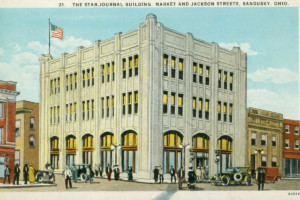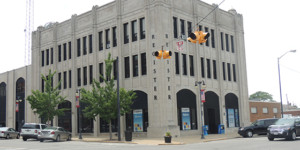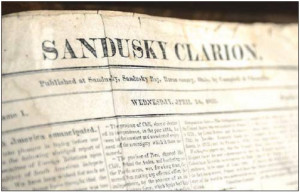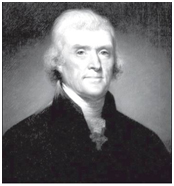 SANDUSKY REGISTER / STAR JOURNAL BUILDING
SANDUSKY REGISTER / STAR JOURNAL BUILDING
Sandusky Register (postcard), ca. 1925. Image courtesy of Sandusky Library Archives Research Center

Although the Sandusky Register building was built in the early 1920s, its history goes back to the early 1820s. For a city this size, it had an unusually abundant number of newspapers to serve the community. Here are the largest ones. there were, however, there were also several German newspapers and small local papers. All of the newspapers below have been microfilmed and can be viewed at the Sandusky Library.
The Clarion – 1822-1848
Daily Sanduskian – June 1, 1849 to May 23, 1851
Sandusky Daily Commercial Register – May 27, 1851 to October 17, 1867
Sandusky Register – October 19, 1967 to 2003
Sandusky Weekly Register – January 6, 1866 to December 31, 1913
Sandusky Local – November 18, 1882 to December 25, 1886
Sandusky Local & Journal Local – January 8, 1887 to December 31, 1887
Sandusky Weekly Journal – January 8, 1879 to December 31, 1887
Sandusky Weekly Journal – January 9, 1879 to December 29, 1900
Sandusky Star – July 18, 1899 to December 24, 1904

The Sandusky Register has been in production since 1822, originally known as the Sandusky Clarion. Published in a building at the corner of Columbus Avenue and East Water Street, the Clarion became a daily newspaper on April 24, 1848. The Clarion office burned down in January 1852, Rechristened the Daily Register, the paper continued to grow with its city, becoming a paper of Republican affiliation in 1856.
Originally known as the Sandusky Clarion, the paper was published starting in 1822—only a few years following the founding of the city—in a small building at the corner of Columbus Avenue and East Water Streets. The newspaper was founded and grounded in American newspaper traditions started by Benjamin Franklin and others in the 1730s. It was also part of the penny press movement spurred by Horace Greeley and others beginning in the 1830s, as publishing technologies advanced and newspapers began to flourish across the country. The Clarion became a daily newspaper in 1848; however the Clarion office burned down in 1848 destroying almost all files.
In 1859, the paper was renamed the Commercial Register. The name plate Sandusky Register first appeared in 1869 when Isaac Foster Mack bought the Register.
 I. F. Mack was an abolitionist, a Civil War veteran and an Oberlin College graduate who moved here to be a newspaperman. He served as the Register’s editor and publisher until 1909, and during his tenure he was a supporter of the industrialization of early Sandusky, and an industrialist himself. He was civic minded and pushed for reforms and innovations to improve the quality of life in his community. “I.F.,” as he was known, was a founder of the Associated Press of the Western Reserve and he is the man most responsible for bringing the Soldiers Home to Sandusky. He hoped to make sure that every veteran of America’s great war would have dignity in old age, and he succeeded in that effort. That success continues to this day at the Ohio Veterans Home, which has served thousands of families for generations. Mack’s sons, his grandsons and descendants are still continued Mack’s tradition and still own the newspaper.
I. F. Mack was an abolitionist, a Civil War veteran and an Oberlin College graduate who moved here to be a newspaperman. He served as the Register’s editor and publisher until 1909, and during his tenure he was a supporter of the industrialization of early Sandusky, and an industrialist himself. He was civic minded and pushed for reforms and innovations to improve the quality of life in his community. “I.F.,” as he was known, was a founder of the Associated Press of the Western Reserve and he is the man most responsible for bringing the Soldiers Home to Sandusky. He hoped to make sure that every veteran of America’s great war would have dignity in old age, and he succeeded in that effort. That success continues to this day at the Ohio Veterans Home, which has served thousands of families for generations. Mack’s sons, his grandsons and descendants are still continued Mack’s tradition and still own the newspaper.
A charter member of the Western Associated Press, parent of the present Associated Press, the Register was one of the first newspapers able to supply, through radio dispatch, instant news. In 1929, the Sandusky Register purchased the Democratic-affiliated paper the Sandusky Star-Journal and moved to its present location at Jackson and Market Streets in Sandusky. Both the Register and the Star-Journal continued publication under the corporate name of Sandusky Newspapers Inc. In 1941, the company acquired the rival Sandusky News, and the name on all editions was changed to the Register Star-News. The paper resumed its original name Sandusky Register in 1958.
In the 19th century (and well into the 20th) most newspapers strongly identified with a particular political party or political philosophy. The Register was an early supporter of the new Republican Party, starting in 1856. Throughout the Civil War era it strongly supported Abraham Lincoln and the Union war effort and referred to the South, and anyone not foursquare for the Union, as “traitors.”
 In 1929, the Register purchased the Democratic-affiliated paper the Sandusky Star-Journal and moved to its present location at Jackson and Market Streets. The company purchased its remaining competitor, the Sandusky News, in 1941. The new masthead read the Register Star-News. In 1958, the paper resumed using its original name, the Sandusky Register.
In 1929, the Register purchased the Democratic-affiliated paper the Sandusky Star-Journal and moved to its present location at Jackson and Market Streets. The company purchased its remaining competitor, the Sandusky News, in 1941. The new masthead read the Register Star-News. In 1958, the paper resumed using its original name, the Sandusky Register.
The Register building was originally built for the Star Journal in 1921. The gray building is a fine example of the Modernistic style popular in the period. The architect was Henry Millott, who also designed Sandusky’s Third National Bank on Market Street. The building features stained glass windows created by a noted Cleveland artist, R. Tolland Wright, and tells the story of the printing industry from the time of the town crier to the modern newspaper.
The interior of the building with its dark paneling, stained glass windows and other fixtures retains the look and feel of the 1920s. Since management fell to both of the Mack Brothers, identical offices were built on the second floor mezzanine, overlooking the 2-story floor below. Many of the original features shave been preserved. One office still remains, while the other has been converted to office space. Much of the original decor can be seen in those rooms which have spectacular crown moldings, carved doors and several spectacular stained glass windows, each with newspaper-related designs. The actual printing of this and other newspapers, is done on site in the rear of the building on a press purchased in the 1950’s. The large rolls of newsprint feed up from the basement. They are so large that, if stretched out the door on Columbus Ave, the paper would would not run out until it reached the Route 2 intersection on Rt. 250. Since all transactions were cash, a massive safe was built. It still bears the name Star-Journal.











